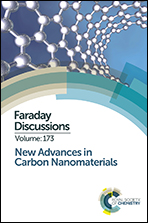Chameleon-like behaviour of cyclo[n]paraphenylenes in complexes with C70: on their impressive electronic and structural adaptability as probed by Raman spectroscopy†
Abstract
A series of four 1 : 1 host–guest supramolecular complexes of [n]CPPs and C70 have been analyzed by Raman spectroscopy in the solid state and complemented with the analysis of their spectroscopic responses under mechanical and thermal stresses. By following the frequency behaviour of the G and RBM modes we have found that [10]CPP in the [10]CPP@C70 complex displays a more “ordered” structure. However, in [11]CPP@C70, the nanoring becomes oval-shaped with closer contacts with the C70 poles and less conformational restriction in the flattened region. By mechanical and thermal stresses we are able to modify the lying conformation of [10]CPP@C70 towards a standing orientation. [11]CPP@C70 resists pressure changes, although it tends to shift from the standing to the lying orientation by heating. As for the crystal cell, the [n]CPPs occupy the residual empty spaces while the main crystallographic positions are reserved for C70. These are new examples of the impressive adaptability of the [n]CPP molecules to different physico-chemical environments, a chameleon-like property which reveals the delicate equilibrium provided by cyclic conjugation and ring strain.
- This article is part of the themed collection: New Advances in Carbon Nanomaterials

 Please wait while we load your content...
Please wait while we load your content...